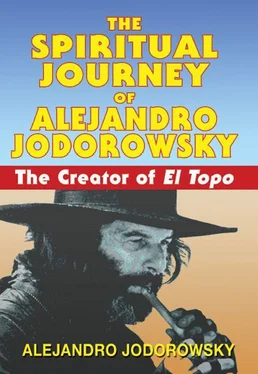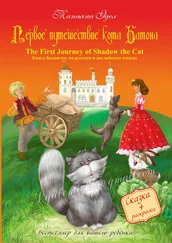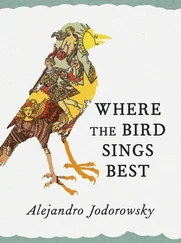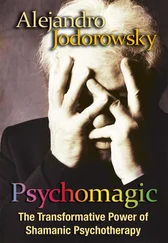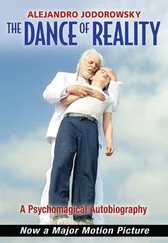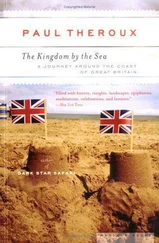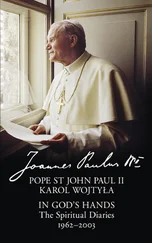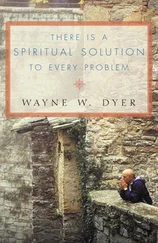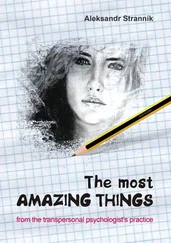Confidently and with perfect style, this invader responded to every challenge presented by my master. There was such an intensity between the two men that we disciples began to dissolve little by little into the shadows.
Ejo asked him: “When you have turned into ashes, how will you hear yourself?” Again, the youth stretched out his hand.
Then Ejo said: “Is it possible that this one hand could be cut off by the sword of Suimo, which is the sharpest of all swords?”
With a smug expression, the visitor answered: “If it is possible, show me that you can do it.”
Ejo insisted: “Why can’t the Suimo sword cut off this hand?”
The youth smiled: “Because this hand reaches through the whole universe.”
Ejo arose, came close to the visitor’s face, and said loudly: “What is this one hand?”
The man answered, shouting even louder: “It is the sky, the earth, man, woman, you, me, the grass, the trees, motorcycles, and roast chickens! All things are this one hand!”
Ejo now murmured very softly: “If you hear the sound of one hand, make me hear it too.”
The young man arose, slapped Ejo in the face, and sat down.
The sound this made was like a rifle shot to us. We were on the verge of jumping this insolent youth and giving him a sound thrashing, but the master restrained us with a smile.
He asked the young man: “Now that you have heard the sound of one hand clapping, what are you going to do?”
The visitor answered: “Ride my motorcycle, smoke a joint, take a piss.”
In an urgent voice, the master commanded him: “Imitate this sublime sound of one hand clapping!”
The youth imitated the sound of a truck that happened to be passing in the street at that moment: “Vroooom. .”
The monk let out a deep sigh. Then he asked him: “This one hand — how far can it travel?”
The youth leaned over and pressed his hand on the floor. “It can go no farther than this.”
Ejo Takata burst into laughter, and in an astounding gesture that left no room for ambiguity, he offered his place to the visitor. The latter, assuming the air of a proud winner, sat down in the master’s place.
“You have done very well in resolving this koan. It was first posed by Hakuin Ekaku.” *4
Here the youth interrupted the master, demonstrating his erudition, “Yes, Hakuin, the great Japanese Zen monk, born in 1686 and died in 1769.”
Ejo bowed respectfully. Then he continued. “Now that you have demonstrated the perfection of your enlightenment, I request that you explain the significance of your gestures and words to my disciples, who are most intrigued by them. Can you do this?”
“Of course I can,” Master Peter (for this was how he now wished us to address him) replied proudly.
“When this monk asked me to prove that I had heard the sound of one hand clapping, I swept away any rationalization with a gesture meaning, ‘It is what it is.’ When he asked me if I was going to be a Buddha — to become enlightened — I did not fall into the dualistic trap of enlightenment — nonenlightenment. What nonsense! My outstretched hand says, ‘Unity, here and now!’ As for when I have become ashes, I did not fall into the trap of existence — nonexistence. If I am, I am here and now — that’s all! The concept of ‘after death’ exists only when we are alive. As for the Suimo sword that cuts everything, I replied that there is nothing to be cut. Why can this one hand not be cut? Because it fills the universe, eliminating all distinction. When he asked that I make him hear the sound of one hand clapping, I slapped him to show that he should not underestimate his own understanding of the koan. And I knew he was setting a trap for me when he asked me to imitate the ‘sublime’ sound of one hand clapping. Expecting some extraordinary experience is an obstacle on the path to enlightenment. By imitating an ordinary sound that occurred at the moment, I was showing him that there is no difference between ordinary and extraordinary. As for the question of what I am going to do now that I am enlightened, I simply gave some details of my everyday actions. There is no need for future plans regarding enlightenment! We must understand that we have always been enlightened without realizing it. He also tried to trip me up with the question, ‘How far can this hand go?’ Enlightenment, however, is not located in space.”
Well-satisfied with his own words, Master Peter now tapped his own belly, exclaiming with a proud, authoritative tone: “Here! Only here, and nowhere else but here!”
Faced with such obvious arrogance and vanity, we were hoping that Ejo would now expel this American from his place. We were appalled at the prospect of having to accept this character as a teacher. But Ejo did nothing. He simply sat there as if he had now become a disciple.
Smiling, he said to Master Peter: “In Hakuin’s teaching there are two koans that are more important than all the others. You have resolved the first of these with perfection. Now I would like to see if you can resolve the second. .”
“Of course!” the American interrupted with a smug expression. “You mean the question about the nature of a dog.”
“Yes. The question to which Joshu gave the answer. .”
Again, Peter interrupted, reciting with speed and precision: “Joshu, the central figure of Chinese Zen, born in 778 CE. While still very young, he began to study with Master Nansen. *5When Nansen died, Joshu was fifty-seven years old. He remained in the monastery for three more years, honoring the memory of his master. Then he left in a quest for truth. He traveled for twenty years. At the age of eighty, he settled in his native village in the province of Jo. There he taught until his death at the age of one hundred.”
“What amazing erudition!” Ejo exclaimed.
Then, looking in our direction, he ordered us: “Applaud!” I joined my companions, but I was applauding with a feeling of jealousy. Master Peter stood up and bowed to us in return with several ostentatious flourishes.
“Now let us see,” Ejo continued. “A monk asked Master Joshu: ‘Does a dog have Buddha nature?’ Joshu answered: ‘Mu.’ What do you say?”
Peter began to stand up, muttering, “ Mu in Chinese means ‘no’; it means nonexistence, emptiness — it might as well be a tree, a barking dog, whatever. .” Now standing and facing Ejo Takata, he yelled so loudly that the windows shook: “MU!”
Then began another round of the duel of questions and answers.
“Give me the proof of this Mu.”
“MU!”
“If that is so, then how will you awaken?”
“MU!”
“Very well. Now when you have been cremated, what will become of this Mu?”
“MU!”
The gringo’s yells were growing louder. Yet Takata, by contrast, was questioning him in a tone that was more and more gentle and respectful. Little by little, he seemed to abase himself utterly before this exalted being who always found the right answer instantly. I was afraid that the dialogue might continue on this way for hours, but now a subtle change took place. The responses were becoming longer.
“On another occasion, when Joshu was asked if a dog had Buddha nature, he answered yes. What do you think of that?”
“Even if Joshu said that a dog has Buddha nature, I would simply yell ‘MU!’ with all my strength.”
“Very good. Now tell me: How does your enlightenment act with Mu?”
Peter stood up and walked a few paces, saying: “When I walk, I walk.” Then, sitting down again, he said: “When I sit, I sit.”
“Excellent! Now explain the difference between the state of Mu and the state of ignorance.”
“I got on my motorcycle and rode to Reforma Boulevard. Then I walked to the government palace. Then I walked back to Reforma, got on my motorcycle, and rode it here.”
Читать дальше
